The debut of the new Terrace Theater plaza fountains in mid-May represented the culmination of a master plan to transform the Long Beach Convention & Entertainment Center’s underutilized venues into turnkey event spaces that are not only contemporary, functional and visually unique, but that also offer a cost savings to clients.
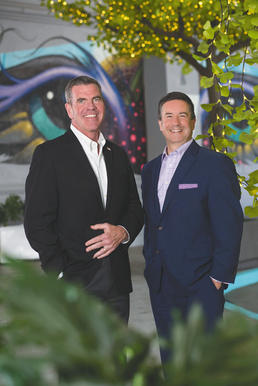
Charlie Beirne, left, general manager of the Long Beach Convention & Entertainment Center, and Steve Goodling, president and CEO of the Long Beach Convention & Visitors Bureau, have collaborated over the past several years to position Long Beach as one of the top destination cities in the country. (Photograph by Matt Fukushima)
As a result of the innovation behind these improvements, both the center itself and the Long Beach Convention & Visitors Bureau (CVB) have been recognized again and again for excellence in the convention industry. In 2017, the CVB was named “Best CVB in the West” at the Stella Awards, put on by two of the industry’s largest publications, Successful Meetings Magazine and Meetings & Conventions Magazine. To achieve the honor, the CVB had to beat out some of the largest cities in the Western U.S., including Las Vegas. The convention center also picked up a second place Stella for “Best Convention Center in the West,” beat out only by Honolulu, Hawaii’s facility.
Last year, CVB President and CEO Steve Goodling was named among the 25 most influential people in the meetings industry by Successful Meetings. The CVB won several other awards for its service and achievements in 2017, including the “Prime Site Award of Excellence” and the “Top Destination Award of Excellence” from Facilities & Destinations Magazine.
“There are larger cities than us. And yet, we’re getting a lot of press. You quite honestly don’t read anything about a lot of other convention centers being innovative,” Goodling told the Business Journal.
The re-imagining of the convention center began with the debut of the Pacific Room at the Long Beach Arena in 2013. The Arena was outfitted with a lighting and truss system capable of transforming the venue for events ranging in size from corporate banquets to sports competitions. TheatreDNA, a Los Angeles-based theater consulting firm, designed professional stage lighting for the venue, and the convention center amassed an array of hip furniture and decor – all offered to clients for no extra cost. That year, the redesigned Pacific Gallery, formerly referred to simply as the Arena lobby, and its revamped restaurant, Bogart & Co., also debuted.
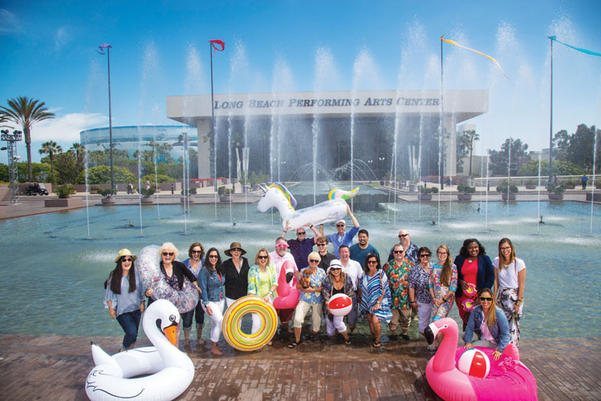
The Long Beach Convention & Visitors Bureau staff splashes into summer at the new Terrace Theater plaza fountains. Pictured, from left, in the front row: Lori Elgayar, Pauline Taylor, Shannon Yates, Heather Gonzalez, Susan Valen, Yvonne Riner, Gary Watters, Cindy Robbins, Sammy the puppy, Iain Campbell, Claudette Baldemor, Steve Goodling, Karen Thomas, Bob Maguglin, Jan Miller, Erica Morris, Loren Simpson, Lilian Olguin and Jamie Weeks. Pictured in the back row: James Robinson, Gregg Haniford, Aristotle Marinas and Jeff Forney. (Photograph by Matt Fukushima)
The CVB has booked 140 conventions because of the addition of the Pacific Room, Goodling reported. The Arena is now in use about 254 days per year, in comparison to the 154 active use days it was averaging before improvements were made, he noted.
Last year, the center unveiled its next biggest transformation: the conversion of an underpass outside the Seaside Ballroom beneath the plaza into an outdoor event space, also equipped with stage lighting and re-envisioned with nautical elements to give it an under-the-ocean feel. The space is called The Cove.
Following The Cove, the Rainbow Bridge, a pedestrian bridge connecting the center’s Pine Avenue promenade to the Terrace Theater plaza, debuted late last year. The bridge not only provides better connectivity throughout the center, but also mimics the lighting design of the center’s new turnkey venues with programmable LED lights lining its length.
Amongst these venues, a common element is lighting – each were outfitted with similar lighting schemes and equipment by TheatreDNA, Goodling explained. Charlie Beirne, general manager of the convention center, noted that his staff is able to program the lighting and sound for each space to create a cohesive, immersive experience so that, if multiple venues were to be utilized at once, their elements would be in sync as guests walked from area to area.
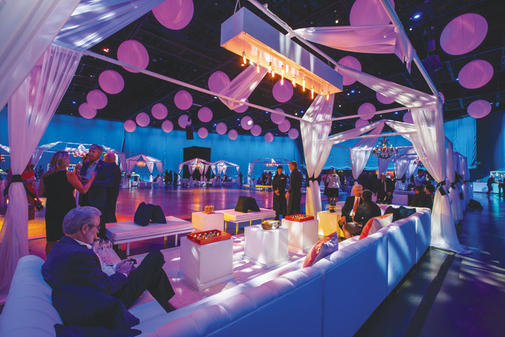
Over the past five years, multiple re-imagined events venues have debuted within the Long Beach Convention & Entertainment Center, from the Pacific Room at the Long Beach Arena, outfitted with a theatrical truss and lighting system able to accommodate corporate luncheons, concerts, major sporting events and more; to the urban, outdoor underpass setting of the Cove, complete with sparkling neon trees, plenty of space for dancing and perfect for food trucks; to the Rainbow Bridge, an LED-lit art piece that does double duty as a connection from the Terrace Theater to the center’s Pine Avenue promenade. (Photograph provided by the Long Beach Area Convention & Visitors Bureau)
The total investment in the Pacific Room, Pacific Gallery and Bogart’s, The Cove, The Terrace Theater plaza and the Rainbow Bridge amounts to just over $25 million, much of which was funded by the city’s Tidelands Fund. The CVB and SMG, the management company that operates the convention center, also chipped in, according to Goodling.
Now, with the debut of the fountains, which offer colorful Bellagio-style water shows programmed to music, these contemporary venues combine to put the center on “the cutting edge” amongst its competition, according to Beirne. “Steve [Goodling] says it all the time and I agree wholeheartedly that we certainly are ahead of the curve moving forward to attract new business compared to other convention centers,” he said.
Goodling pointed out that equipping the convention center with unique event spaces is a major component of keeping the center competitive. The facility’s main source of competition is among big box hotels, which offer both sizable convention and meeting space in addition to hotel rooms and food service.
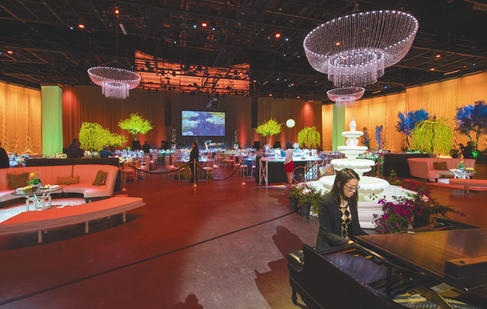
(Photograph of the Pacific Room provided by the Long Beach Area Convention & Visitors Bureau)
“Generally speaking, those hotels will greatly reduce the rental rate for the meeting space because they are making their [profit] on the in-house food and beverage that’s captured, and the room service and the hotel sleeping rooms,” Goodling explained. Convention centers like the one in Long Beach don’t have those additional revenue streams, making it more difficult to keep rental rates for meetings competitive. “As an organization, we have to help offset the convention center’s costs. We share those rental reduction requests with our board and they help in reviewing and approving what needs to be done, and Charlie will reduce his rental [rates] and the hotels will also contribute additional monies to help offset [the reduction],” Goodling explained.
“That’s why our drive to create these unique spaces has been so important, because these unique spaces set us apart,” Goodling said. “You really can’t find these in large box hotels, nor can you find them in other convention centers.”
The center has picked up a lot of short-term business, events that are booked without much advance notice, this year, according to Goodling. He estimated that, by year’s end, meeting and convention bookings will have increased up to 3% in comparison to 2017. “Next year, our convention business is looking strong. We’re up about 14% and, even though the economy is softening in many markets in terms of convention business, we still have a lot on the books and we should be doing very fine next year,” he said.
What’s Next?
Goodling and Beirne haven’t stopped dreaming of more improvements to make to the center. In fact, they argue that some changes will be necessary to accommodate the Olympics in 2028.
“In order for the Arena to be successful with the Olympics, it needs . . . sports lighting up to international standards. It needs new stadium seats. We also really need to revisit the exterior,” Goodling said. “And we also need to enhance the space on the backside of the Arena lobby, which basically is more or less an area for trucks to drive up to. . . . You’re along the waterfront, the Pacific Ocean. You really should be using that as a venue.”
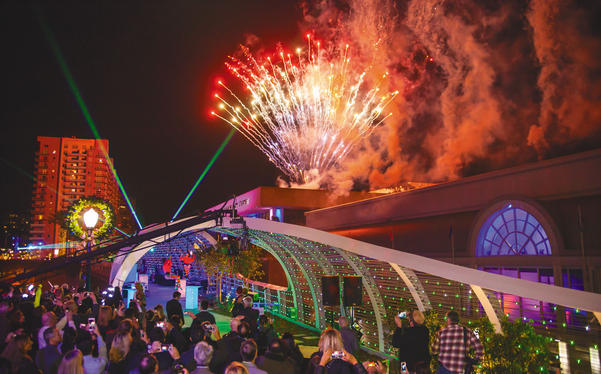
(Photograph of the Rainbow Bridge provided by the Long Beach Area Convention & Visitors Bureau)
Goodling added the bathrooms in the Arena also need to be redone. “The entire facility of the Arena needs work before 2026,” he said. Beirne pointed out that the concessions areas in the Arena date back to 1962, and also need updating.
“The other thing that has been discussed . . . is building some type of deck that overlooks the Pacific Ocean off of the Arena,” Goodling mused. “You could do private functions on this deck for 400 to 500 people, and then building a kitchen. The view is looking down the coast.”
Discussions about future improvements are in preliminary stages, Goodling noted, adding that the mayor and city staff have inquired about how to best prepare the facility for the Olympics. He estimated that, to be ready in time, improvements need to get going within the next three years.
